Pricing Guides & Dictionary of Makers Marks for Antiques & Collectibles

COLLECTIBLE CRANBERRY GLASS:
A Collector's Guide
Join the most updated and complete collectibles research online - Learn more...
 Cranberry glass, with its distinctive pinkish-red hue, has been a favorite of collectors and enthusiasts for centuries. Whether you're a seasoned collector or just starting out, there's plenty to learn about this fascinating art form. In this article, we'll explore the history of cranberry glass, its characteristics and unique features, and provide tips on how to research and authenticate your own pieces.
Cranberry glass, with its distinctive pinkish-red hue, has been a favorite of collectors and enthusiasts for centuries. Whether you're a seasoned collector or just starting out, there's plenty to learn about this fascinating art form. In this article, we'll explore the history of cranberry glass, its characteristics and unique features, and provide tips on how to research and authenticate your own pieces.
What is Cranberry Glass?
Cranberry glass is a type of glassware that has a distinctive pinkish-red color, resembling the color of cranberries. This unique color is achieved by adding gold or colloidal gold to the glass mixture during production. The exact origins of cranberry glass are unclear, but it is believed to have been first produced in the late 17th century in Bohemia (now the Czech Republic), a region renowned for its glassmaking traditions.
During the 19th century, cranberry glass became increasingly popular in Europe and the United States, and many glass manufacturers began producing their own versions of the distinctive pinkish-red glass. Today, cranberry glass continues to be produced by a variety of manufacturers and remains a popular collectible item.
Features and Characteristics of Cranberry Glass
One of the defining features of cranberry glass is its distinctive color. While the exact shade of cranberry glass can vary depending on the specific manufacturing techniques used, most pieces will have a pinkish-red hue that is unlike any other type of glassware.
Another characteristic of cranberry glass is its translucency. When held up to the light, cranberry glass will allow some light to pass through, giving it a unique glow that can be especially striking in decorative pieces.
Cranberry glass is also known for its intricate designs and patterns. Many pieces feature etched or engraved designs, as well as applied decorations like gold or silver accents. These decorative elements can add to the value and beauty of a piece of cranberry glass.
How to Research and Authenticate Cranberry Glass
If you're interested in collecting or learning more about cranberry glass, there are several steps you can take to research and authenticate pieces.
1. Consult Reference Books and Online Resources
There are many reference books and online resources available that can provide valuable information about cranberry glass. These resources can help you learn about the history and manufacturing techniques of cranberry glass, as well as provide guidance on identifying and authenticating pieces. Some popular reference books on cranberry glass include "Cranberry Glass: Collecting for Pleasure" by Sue C. Davis and "Cranberry Glass: A Collector's Guide" by Paul A. Ysart.
2. Attend Antique Shows and Auctions
Attending antique shows and auctions can be a great way to learn more about cranberry glass and see examples of authentic pieces. You can talk to dealers and other collectors to learn about their experiences and get advice on collecting and identifying cranberry glass. Be sure to ask plenty of questions and examine pieces closely to get a better understanding of their unique features and characteristics.
3. Examine Pieces Closely
When examining cranberry glass pieces, there are several factors to consider. First, examine the color and translucency of the glass. Cranberry glass should have a distinctive pinkish-red hue and some degree of translucency when held up to the light. Next, look for decorative elements like etched or engraved designs, as well as applied decorations like gold or silver accents. These can help authenticate a piece and add to its value. Finally, pay attention to the overall quality of the glass, including any signs of wear or damage. High-quality cranberry glass should have a smooth surface and crisp, clear details.
4. Look for Maker's Marks and Signatures
Many pieces of cranberry glass will feature maker's marks or signatures, which can help authenticate the piece and provide valuable information about its origin and history. Look for these marks on the bottom or side of the piece, and do some research to learn more about the manufacturer and their history.
5. Consult with Experts
If you're serious about collecting cranberry glass, it may be worth consulting with experts in the field. Glass appraisers and antique dealers who specialize in cranberry glass can provide valuable insights and guidance on collecting, authenticating, and valuing pieces.
Conclusion
Cranberry glass is a beautiful and unique type of glassware that has been cherished by collectors and enthusiasts for centuries. By understanding the history and unique features of cranberry glass, as well as how to research and authenticate pieces, you can develop a deeper appreciation for this fascinating art form and build a collection that you can be proud of. Whether you're a seasoned collector or just starting out, there's always more to learn about cranberry glass and the rich history and culture that surrounds it.
Unlock the true value of your collection with our comprehensive research guides from identifying makers' marks to appraising all kinds of antiques and collectibles, including items featured in this article.
Our up-to-date information will give you an accurate understanding of your items' worth. Don't miss out on this valuable resource - visit our research tools today!
In addition to some examples shown below on this page, you can also search our price guide for your own treasures.
Examples of related items from our Price Guides
-
 (LOT OF 12) ASSORTED ART GLASS TUMBLERS
[more like this]
(LOT OF 12) ASSORTED ART GLASS TUMBLERS
[more like this]
-
 (LOT OF 16 ) COLLECTION OF AMERICAN ART
[more like this]
(LOT OF 16 ) COLLECTION OF AMERICAN ART
[more like this]
-
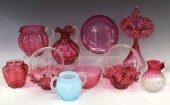 (10) COLLECTION VINTAGE ART GLASS INCLUD
[more like this]
(10) COLLECTION VINTAGE ART GLASS INCLUD
[more like this]
-
 (8 PCS) CRANBERRY & RUBY GLASS VESSELS I
[more like this]
(8 PCS) CRANBERRY & RUBY GLASS VESSELS I
[more like this]
-
 (TOPICAL) CRANBERRY INDUSTRY: 51 POSTCAR
[more like this]
(TOPICAL) CRANBERRY INDUSTRY: 51 POSTCAR
[more like this]
-
 24 ASSORTED GLASS DECANTERS, LIQUEUR BOT
[more like this]
24 ASSORTED GLASS DECANTERS, LIQUEUR BOT
[more like this]
-
 7 PIECES CRANBERRY GLASS WITH SILVERPLAT
[more like this]
7 PIECES CRANBERRY GLASS WITH SILVERPLAT
[more like this]
-
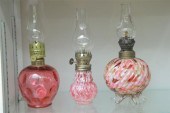 GROUP OF THREE MINIATURE RUBY GLASS LAMP
[more like this]
GROUP OF THREE MINIATURE RUBY GLASS LAMP
[more like this]
-
 SEVEN PIECES OF CRANBERRY & RUBY GLASS S
[more like this]
SEVEN PIECES OF CRANBERRY & RUBY GLASS S
[more like this]
-
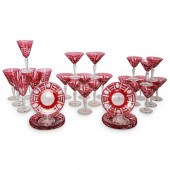 (32 PC) WILLIAM YEOWARD GLASS SETDESCRIP
[more like this]
(32 PC) WILLIAM YEOWARD GLASS SETDESCRIP
[more like this]
-
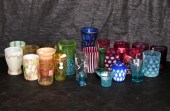 Twenty-Five-Piece Collection of Glasswar
[more like this]
Twenty-Five-Piece Collection of Glasswar
[more like this]
-
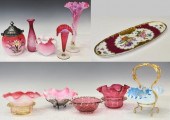 (11) VICTORIAN & 20THC. ART GLASS CABINE
[more like this]
(11) VICTORIAN & 20THC. ART GLASS CABINE
[more like this]
There are many more auction results available to our members...





